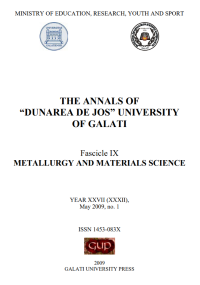Heavy Metal Ions Cu (II), Co (II) and Cr (III) Bifunctionally Improved with Hydroxamic and Amidoxime Groups Chelating Ion Exchangers
Abstract
Two new types of bifunctional chelating ion exchangers on the basis of ethylacrylate acrylonitrile: divinylbenzene copolymers with hydroxamic acid and amidoxime groups have been evaluated for Cu(II), Co(II) and Cr(III)ions sorption from unbuffered diluted aqueous solutions. To model the retention and to compare the sorption capacity of bifunctional acrylic chelating sorbents for the tested cations the Langmuir and Freundlich isotherm equations have been used. The Langmuir maximum sorption capacities for the sorbent of type A were determined to be 2.081, 1.423 and 1.384 mmole/g for Cu (II), Co (II) and Cr (III), respectively. The increase of cross- linking degree for the bifunctional chelating ion exchanger of type B resulted in the decrease of its sorption capacity toward heavy metal ions under study. The negative values of ΔG in all cases point to the spontaneous character of the sorption process. The kinetics of the Cu (II), Co (II) and Cr (III) sorption follows the Lagergren pseudo – first order model. The results are significant for the future development of the tested sorbents into beneficial materials for industrial and environmental applications.
Downloads
References
[2]. A.K. Majundar - N- Benzoylphenylhydroxylamine and its Analogues, Pergamon Press, London,1971.
[3]. Y.K. Agrawal - Rev. Anal Chem., 5(1980), 3.
[4]. F. Vernon, H. Eccles, Anal.Chim. Acta, 83(1976), 187.
[5]. I.P.Alimarin, F.P.Sudakov, B.C.Golovkin - Russ. Chem. Rev., 31(1962), 466.
[6]. W.Kern, R.C.Schulz - Angew.Chem., 69(1957),153.
[7]. A.L.Crimbliss, J.M.Garisson - Inorg. Chim.Acta, 133(1987), 281.
[8]. G.Petrie, D.Locke, C.E.Meloan - Anal.Chem., 37(1965), 919.
[9]. F.Shoutedeu, Makrom.Chem.,27(1958), 246.
[10]. A.Shah,S.Devi, Analyst, 110(1985), 1501.
[11]. A.Shah,S.Devi,Analyst,112(1987), 325.
[12]. U.S.Patent,4,868 (1989), 278.
[13]. J.Domb, E.G.Cravalho, R.Langer, J.Polym.Sci., 26(1988), 2623.
[14]. F.Vernon, H.Eccles, Anal.Chim.Acta, 77 (1975),145.
[15]. F.Vernon, H.Eccles, Anal.Chim.Acta, 79, (1975), 229.
[16]. F.Vernon, H.Eccles, Anal.Chim.Acta, 94(1977), 317.
[17]. F.Vernon, Pure Appl.Chem., 54, (1982), 2151.
[18]. Y.K.Agrawal, K.V.Rao, React. Polym., 25(1995), 79.
[19]. Y.K.Agrawal, K.V.Rao, React. Funct.Polym., 31(1996), 225.
[20]. H.Egawa, M.Nagayama, E.Sugihara, J.Appl.Polym.Sci., 33(1987), 193.
[21]. H.Egawa, T.Nonaka, S.Abe, M.Nakayama, J.Appl.Polym.Sci., 45(1992), 837.
[22]. N.Kabay, H.Egawa, J.Appl.Polym.Sci., 51(1994), 381.
[23]. N.Kabay, T.Hayashi, A.Jyo, H.Egawa, J.Appl.Polym.Sci., 54(1994), 335.
[24]. T.Takeda, K.Satio, K.Uezu, S.Furusaki, Ind.Eng.Chem.Res., 30(1985), 185.
[25]. K.Saito, T.Yamaguchi, K.Uezu, T.Sugo, J.Appl.Polym.Sci., 39(1990), 2153.
[26]. D.L.Verraest, J.A.Peters, H.C.Kuzee, H.W.C.Raijnakers, H.vanBekkum, Carbohidr. Polym. 37(1998), 209.
[27]. L.M.Ferreira, J.M.Loureiro, A.Rodrigues, Sep.Sci.Technol., 33(1998), 1585.
[28]. F.Vernon, T.Shah, React.Polym.,1(1983), 301.
[29]. L.Rao,J.Xu,R.Zhan, J.Appl.Polym.Sci., 53(1994), 325.
[30]. C.J.Niu, Xiyou Jinshu, 13(1989), 1248.
[31]. W.P.Liu,Y.Lu, H.M.Zeng, J.Appl.Polym.Sci., 47(1993), 45.
[32]. M.Z. Bau, F.L.Yu, C.J.Niu, Fenxi Huaxue, 17(1998), 928.
[33]. H.Omichi, A.Katakai, T.Sugo, Sep.Sci.Technol., 20(1985), 163.
[34]. Y.Zhanhai, R.Lei,X.Jun, J.Appl.Polym.Sci., 83(2002), 1986.
[35]. S.Maxim, A.Flondor, A.Carpov, M.Macoveanu, A.Tofan, Romanian Patent, 84729/04.04.1982.
[36]. S. Maxim, A. Carpov, C.A. Pascu, C. Leonida, G. Mocanu, I. Bunia, M. Sofaru, Romanian Patent, 84595/15.02.1984.
[37]. S.Maxim, A.Flondor, A.Carpov, M.Macoveanu, A.Tofan, I. Bunia, E. Avadanii, Romanian Patent, 96425/23.07.1988.
[38]. V. Neagu, I. Bunia, I. Plesca, M. Popa,J. Appl. Polym. Sci., 88(2003), 2956.
[39]. R. Wenkert, I. Sarghie, I. Bunia, V. Neagu, Annals of the Suceava University 1(2006),13-17.
[40]. R. Wenkert, I. Sarghie, I. Bunia, V. Neagu, ATTIS, vol.VII (2006), nr. 1-2 p. 13-20.
[41]. R. Wenkert, I. Sarghie, S. Moisa, I. Bunia, V. Neagu, Bull. Inst.Polytch. Iasi (Materials Science and Engineering), tomLIII(LVII), fasc.2(2007), 101-107.
[42]. R. Wenkert, I. Sarghie, S. Moisa, V. Neagu, Proceedings of the BRAMAT 2007(International Conference on Materials Science 22- 24 February 2007 Environmental Management and Protection, p. 446.
[43]. H Cornelia, J.Horst, H.H. Wolfgang, React. Funct. Polym. 49(2001), 117-132.
[44]. L. Langmuir, J. Am.Chem. Soc.,38(1916)2221-2295.
[45]. K.R. Hall, L.C. Eagleton,A. Acrivas, T. Vermeulen, Industrial&Engineering Chemistry Fundamentals, 5(2)(1966), 212-223.
[46]. V.K.Gupta, A.Mittal, I. Krishnan, J.Colloid. Interf.Sci., 293(2006), 16-26.
[47]. O. Khazali, R. Abu-El – Halawa, K.Al - Sou’od, Journal Hazard. Material. B139(2007), 67-71.
[48]. W.T.Tsai, K.J. Hsien, Y.M. Chang, C.C.Lo, Bioresource Technol., 96(2005), 657-663.
[49]. M.M. Saeed, M.Ahman, J.Radioanal.Nucl.Chem., 252(2002)744.
[50]. S. Lagergren, Handlinger 24 (1898) 1-39.
[51]. E.A. Moawed, M.A.A. Zaid, M.F. El – Shahat, Acta Chromatographica, 15(2005), 220-237.



